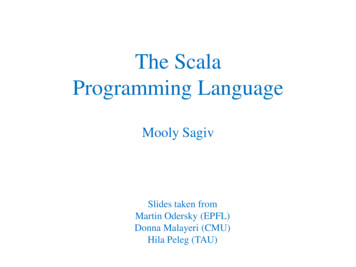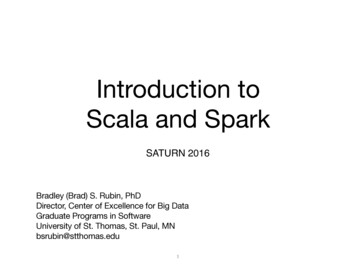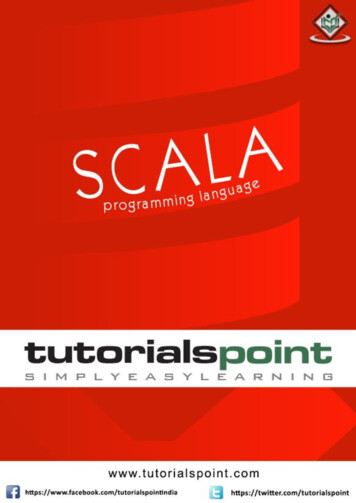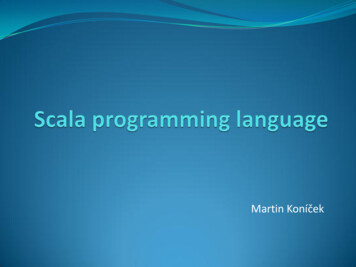
Transcription
The ScalaProgramming LanguageMooly SagivSlides taken fromMartin Odersky (EPFL)Donna Malayeri (CMU)Hila Peleg (TAU)
Modern Functional Programming Higher orderModulesPattern matchingStatically typed with type inferenceTwo viable alternatives Haskel Pure lazy evaluation and higher order programming leads toConcise programming Support for domain specific languages I/O Monads Type classes ML/Ocaml/F# Eager call by value evaluation Encapsulated side-effects via references Object orientation
Then Why aren’t FP adapted? Education Lack of OO support Subtyping increases the complexity of typeinference Programmers seeks control on the exactimplementation Imperative programming is natural in certainsituations
Why Scala?(Coming from OCaml) Runs on the JVM/.NET Can use any Java code in Scala Combines functional and imperative programmingin a smooth way Effective library Inheritance General modularity mechanisms
The Java Programming Language Designed by Sun 1991-95Statically typed and type safeClean and Powerful librariesClean references and arraysObject Oriented with single inheritanceInterfaces with multiple inheritancePortable with JVMEffective JIT compilersSupport for concurrencyUseful for Internet
Java Critique Downcasting reduces the effectiveness ofstatic type checking Many of the interesting errors caught at runtime Still better than C, C Huge code blowouts Hard to define domain specific knowledgeA lot of boilerplate codeSometimes OO stands in our wayGenerics only partially helps
Why Scala?(Coming from Java/C ) Runs on the JVM/.NET Can use any Java code in Scala Almost as fast as Java (within 10%)Much shorter code Odersky reports 50% reduction in most code over Java Local type inferenceFewer errors No Null Pointer problemsMore flexibility As many public classes per source file as you want Operator overloading
Scala Designed and implemented by Martin Odersky [2001-] Motivated towards “ordinary” programmers Scalable version of software Focused on abstractions, composition, decomposition Unifies OOP and FP Exploit FP on a mainstream platform Higher order functions Pattern matching Lazy evaluation Interoperates with JVM and .NET Better support for component software Much smaller code
Scala Scala is an object-oriented and functionallanguage which is completely interoperable withJava (.NET) Remove some of the more arcane constructs ofthese environments and adds instead:(1) a uniform object model,(2) pattern matching and higher-order functions,(3) novel ways to abstract and composeprograms
Getting Started in Scala scala Runs compiled scala code Or without arguments, as an interpreter! scalac - compiles fsc - compiles faster! (uses a background server to minimize startuptime) Go to scala-lang.org for downloads/documentation Read Scala: A Scalable Language(see anguage.html )
Plan Motivation Scala vs. Java Modularity Discussion
Features of Scala Scala is both functional and object-oriented every value is an objectevery function is a value--including methodsScala is statically typed includes a local type inference system: in Java 1.5:Pair Integer, String p new Pair Integer, String (1, "Scala"); in Scala:val p new MyPair(1, "scala");
Basic Scala Use var to declare variables:var x 3;x 4; Use val to declare values (final vars)val y 3;y 4; // error Notice no types, but it is statically typedvar x 3;x “hello world”; // error Type annotations:var x : Int 3;OCamllet x ref 3 inx : !x 4
Scala is interoperableScala programs interoperateseamlessly with Java classlibraries: Method callsField accessesClass inheritanceInterface implementationobject instead of staticvar: Type instead of Type varmembersobject Example1 {def main(args: Array[String]) {val b new StringBuilder()for (i 0 until args.length) {all work as in JavaScala programs compile toJVM bytecodesScala’s syntax resemblesJava’s, but there are also somedifferencesScala’s version of the extended forloop(use - as an alias for )if (i 0) b.append(" toString)}}Arrays are indexed args(i)instead of args[i]
Scala is functionalArraysinstancesofofsequencesmap isarea methodArraywhich withThe last program can alsobe written in a completelydifferent style: Treat arrays as instances ofgeneral sequenceabstractions Use higher-orderfunctions instead of loopsmap theandfunctionmkStringonmethodsappliesits rightto each array elementobject Example2 {def main(args: Array[String]) {println(args.map ( .toUpperCase) .mkString " ")}}A closure which applies thetoUpperCasemkString is a methodof Arraymethodwhich to its Stringargumentforms a string of all elements witha givenseparator between themmk string map (fun x - toUpperCase(x), args), " "
Functions, Mapping, Filtering Defining lambdas – nameless functions (types sometimesneeded)val f x :Int x 42; f is now a mapping int- int Closures! A way to haul around statevar y 3;val g {x : Int y 1; x y; } Maps (and a cool way to do some functions)List(1,2,3).map( 10).foreach(println) Filtering (and ranges!)(1 to 100). filter ( % 7 3). foreach (println) (Feels a bit like doing unix pipes?)
Scala is conciseScala’s syntax is lightweightand conciseContributors: type inferencelightweight classesextensible API’sclosures ascontrol abstractionsvar capital Map( "US" "Washington","France" "paris","Japan" "tokyo" )capital ( "Russia" "Moskow" )for ( (country, city) capital )capital ( country city.capitalize )assert ( capital("Japan") "Tokyo" )Average reduction in LOC wrt Java: 2due to concise syntax and better abstractioncapabilities
Big or small?Every language designfaces the tension whether itshould be big or small: Big is good: expressive,easy to use Small is good: elegant,easy to learnCan a language be both bigand small?Scala’s approach:concentrate on abstractionand compositioncapabilities instead of basiclanguage constructsScala addsScala removes a pure objectsystem- static members operatoroverloading- special treatment ofprimitive types closures as control - break, continueabstractions mixin compositionwith traits- special treatment ofinterfaces abstract typemembers- wildcards pattern matching
The Scala designScala strives for thetightest possibleintegration of OOP andFP in a statically typedlanguageThis continues to haveunexpectedconsequencesScala unifies algebraic data typeswith classhierarchies, functions withobjectsHas some benefits withconcurrency
ADTs are class hierarchiesMany functionallanguages have algebraicdata types and patternmatching Concise and canonicalmanipulation of datastructuresObject-orientedprogrammers object: ADTs are not extensible, ADTs violate the purity ofthe OO data model Pattern matching breaksencapsulation and it violatesrepresentationindependence!
Pattern matching in ScalaThe case modifier of an object or class meansyou can pattern match on itabstract class Tree[T]Here's a a set ofdefinitions describing case object Empty extends Treebinary trees:case class Binary(elem: T, left: Tree[T], right: Tree[T])extends TreeAnd here's aninorder traversal ofbinary trees:This design keepsdef inOrder [T] ( t: Tree[T] ): List[T] t match {case Empty List()case Binary(e, l, r) inOrder(l) ::: List(e) ::: inOrder(r)} purity: all cases are classes or objects extensibility: you can define more cases elsewhere encapsulation: only parameters of case classes are revealed representation independence using extractors [Beyond the scope of thecourse]
Pattern Scala vs. OCamlabstract class Tree[T]case object Empty extends Treecase class Binary(elem: T, left: Tree[T], right: Tree[T])extends Treedef inOrder [T] ( t: Tree[T] ): List[T] t match {case Empty List()case Binary(e, l, r) inOrder(l) ::: List(e) ::: inOrder(r)}type Tree Empty Binary of Element * Tree * Treelet rec InOrder (t : tree) match t with Empty - [] Binary (element, left, right) - List.append(List.append(inOrder(left), [element]), InOrder(right))
Mutable vs. Immutable DataStructures Basic data structures in Scala are immutable Operations will copy (if they must)xabcyy x.drop(2)z x.map( "h")zahbhchx Many positive consequencesabcy
Mutable vs. Immutable Mutable and immutable collections are not thesame type hierarchy! Have to copy the collection to change back andforth, can’t castx.toListListMutableList
More features Supports lightweight syntax for anonymousfunctions, higher-order functions, nested functions,currying ML-style pattern matching Integration with XML can write XML directly in Scala program can convert XML DTD into Scala class definitions Support for regular expression patterns
Other features Allows defining new control structureswithout using macros, and whilemaintaining static typing Any function can be used as an infix orpostfix operator Semicolon inference Can define methods named , or ::
Automatic Closure Construction Allows programmers to make their owncontrol structures Can tag the parameters of methods with themodifier def When method is called, the actual defparameters are not evaluated and a noargument function is passed
While loop exampleobject TargetTest1 {def loopWhile(def cond: Boolean)(def body: Unit): Unit if (cond) {body;Define loopWhile methodloopWhile(cond)(body);}var i 10;loopWhile (i 0) {Console.println(i);i i–1}}Use it with nice syntax
Scala object system Class-based Single inheritance Can define singleton objects easily (noneed for static which is not really OO) Traits, compound types, and views allowfor more flexibility
Dependent Multiple Inheritance(C )
Traits Similar to interfaces in JavaThey may have implementations of methodsBut can’t contain stateCan be multiply inherited from
Classes and Objectstrait Nat;object Zero extends Nat {def isZero: boolean true;def pred: Nat throw new Error("Zero.pred");}class Succ(n: Nat) extends Nat {def isZero: boolean false;def pred: Nat n;}
More on Traits Halfway between an interface and a class, called atrait A class can incorporate as multiple Traits like Javainterfaces but unlike interfaces they can also containbehavior, like classes Also, like both classes and interfaces, traits canintroduce new methods Unlike either, the definition of that behavior isn'tchecked until the trait is actually incorporated as partof a class
Another Example of traitstrait Similarity {def isSimilar(x: Any): Boolean;def isNotSimilar(x: Any): Boolean !isSimilar(x);}class Point(xc: Int, yc: Int) with Similarity {var x: Int xc;var y: Int yc;def isSimilar(obj: Any) obj.isInstanceOf[Point] &&obj.asInstanceOf[Point].x x &&obj.asInstanceOf[Point].y y ;}
Mixin class composition Basic inheritance model is single inheritance But mixin classes allow more flexibilityclass Point2D(xc: Int, yc: Int) {val x xc;val y yc;// methods for manipulating Point2Ds}class ColoredPoint2D(u: Int, v: Int, c: String)extends Point2D(u, v) {var color c;def setColor(newCol: String): Unit color newCol;}
Mixin class composition oloredPoint2Dclass Point3D(xc: Int, yc: Int, zc: Int)extends Point2D(xc, yc) {val z zc;// code for manipulating Point3Dsclass ColoredPoint3D(x Int, yc: Int, zc: Int, col: String)extends Point3D(xc, yc, zc)with ColoredPoint2D(xc, yc, col);
Mixin class composition Mixin composition adds members explicitlydefined in ColoredPoint2D(members that weren’t inherited) Mixing a class C into another class D is legalonly as long as D’s superclass is a subclass ofC’s superclass. i.e., D must inherit at least everything that Cinherited Why?
Mixin class composition Remember that only members explicitly defined inColoredPoint2D are mixin inherited So, if those members refer to definitions that wereinherited from Point2D, they had better exist inColoredPoint3D They do, sinceColoredPoint3D extends Point3Dwhich extends Point2D
Views Defines a coercion from one type to another Similar to conversion operators in C /C#trait Set {def include(x: int): Set;def contains(x: int): boolean}def view(list: List) : Set new Set {def include(x: int): Set x prepend list;def contains(x: int): boolean !isEmpty &&(list.head x list.tail contains x)}
Covariance vs. Contravariance Enforcing type safety in the presence of subtyping If a function expects a formal argument oftype T1 T2 and the actual argument has atype S1 S2 then what do have to require? If a function assumes a precondition T1 and ensures apostcondition T2 If the caller satisfies a precondition S1 and requires that S2holds after the call What do we have to require?
Variance annotationsclass Array[a] {def get(index: int): adef set(index: int, elem: a): unit;} Array[String] is not a subtype of Array[Any] If it were, we could do this:val x new Array[String](1);val y : Array[Any] x;y.set(0, new FooBar());// just stored a FooBar in a String array!
Variance Annotations Covariance is ok with immutable data structurestrait GenList[ T] {def isEmpty: boolean;def head: T;def tail: GenList[T]}object Empty extends GenList[All] {def isEmpty: boolean true;def head: All throw new Error("Empty.head");def tail: List[All] throw new Error("Empty.tail");}class Cons[ T](x: T, xs: GenList[T]) extends GenList[T] {def isEmpty: boolean false;def head: T x;def tail: GenList[T] xs}
Variance Annotations Can also have contravariant type parameters Useful for an object that can only be written to Scala checks that variance annotations are sound covariant positions: immutable field types, method results contravariant: method argument types Type system ensures that covariant parameters are onlyused covariant positions(similar for contravariant)
Missing Compound typesTypes as membersActors and concurrencyLibraries
Resources The Scala programming language home page(see http://www.scala-lang.org/ ) The Scala mailing list(see http://listes.epfl.ch/cgi-bin/doc en?liste scala ) The Scala wiki (see http://scala.sygneca.com/ ) A Scala plug-in for Eclipse(see html) A Scala plug-in for IntelliJ(see http://plugins.intellij.net/plugin/?id 1347 )
References The Scala Programming Language as presented by Donna Malayeri (seehttp://www.cs.cmu.edu/ aldrich/courses/819/slides/scala.ppt )The Scala Language Specification eference.pdf )The busy Java developer's guide to Scala: Of traits and behaviorsUsingScala's version of Java va/library/j-scala04298.html )First Steps to Scala (in Scalazine) by Bill Venners, Martin Odersky, andLex Spoon, May 9, 2007 .html )
Summing Up [Odersky] Scala blends functional and object-oriented programming. This has worked well in the past: for instance in Smalltalk,Python, or Ruby However, Scala is goes farthest in unifying FP and OOPin a statically typed language This leads to pleasant and concise programs Scala feels similar to a modern scripting language, butwithout giving up static typing
Lessons Learned[Odersky]1.2.3.4.Don’t start from scratchDon’t be overly afraid to be differentPick your battlesThink of a “killer-app”, but expect that in the end itmay well turn out to be something else5. Provide a path from here to there
Scala Adaptation kinVerizen Yammer
Summary An integration of OO and FP Also available in Ruby but with dynamic tryping Static typingConciseEfficientSupport for concurrencyAlready adaptedBut requires extensive knowledge
Languages Ocaml Javascript Scala
Concepts &Techniques Syntax Static semanticsSemantics Small vs. big step Runtime managementFunctional programming Context free grammarAmbiguous grammarsSyntax vs. semanticsPredictive Parsing Scope rules Lambda calculusRecursionHigher order programmingLazy vs. Eager evaluationPattern matchingContinuationTypes Type safetyStatic vs. dynamicType checking vs. type inferenceMost general typePolymorphismType inference algorithm
Getting Started in Scala scala Runs compiled scala code Or without arguments, as an interpreter! scalac - compiles fsc - compiles faster! (uses a background server to minimize startup time) Go to scala-lang.org for downloads/documentation Read Scala: A Scalable Language










